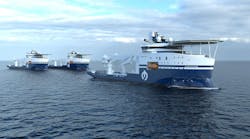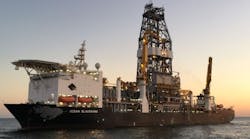JEREMY BECKMAN
EDITOR, EUROPE
TWO OF MAERSK DRILLING’S HARSH ENVIRONMENT JACKUPS have undergone a series of low-emissions upgrades and a third, Maersk Invincible, is due to receive the same package later this year. All three have been working for various Norwegian operators on development drilling, intervention or stimulation programs in the North Sea. The upgrades combine the use of a battery-based hybrid power solution with NOx conversion systems, and energy-efficiency software to monitor and optimize energy consumption and lower carbon-dioxide (CO2) emissions.
In addition, the company has formed a subsidiary Horizon56 to continue development of RigFlow, designed to digitalize the main workflows in the well construction process. The drillship Maersk Voyager is, for example, equipped with RigFlow for its current year-long contract for Shell.
Offshore spoke to Caroline Alting, Head of Integrity Projects at Maersk Drilling and Esben Thorup, Managing Director of Horizon56, about these developments, both of which are set to continue after the company completes its merger with Noble Corp.
***
Offshore: Maersk Intrepid started operating with the full set of low-emissions upgrades while working on Equinor’s Martin Linge development in the North Sea, all commissioned while the rig was offshore. At the time, Maersk Drilling planned a continuous focus on the rig’s fuel consumption. What have been the results so far?
Alting: This is certainly still a focus on Maersk Intrepid and our other rigs, as reducing fuel consumption is key to lowering emissions from drilling operations. Maersk Intrepid is still working for Equinor offshore Norway but is due to commence a contract with OMV Norge mid-year: in this case the contractual terms include an emissions reduction incentive scheme. Equinor paved the way by being the first of our customers to put such an arrangement in place.
Results so far have shown that with the full low-emissions package, and adding the behavioral changes we’re able to leverage from the detailed insights into data, we can realize reductions in fuel consumption and emissions of 25% compared to the rig’s baseline over a sustained period of time. The potential reductions are, however, dependent on the type of operations being performed.
Offshore: Based on the performance to date, have any of the new processes introduced in 2019 since been modified?
Alting: The equipment that contributes most to our overall energy use is the focus of our energy efficiency performance monitoring. Among other things, this means that we are identifying and quantifying losses in our operations in terms of fuel, CO2 and costs. By doing this, we can show the consequence of unfavorable behavior and enable a change in operations. Further, we are able to benchmark rigs directly against each other to make sure that we are sharing best practices across sister rigs.
Overall, we are working to embed energy efficiency deeper into our offshore workflows and processes. This ensures that we maintain an energy-efficient mindset and a structured way of reporting and assessing ideas for improvement. In practical terms, it means that we are `hardwiring’ the conversations offshore through making this a re-occurring item during rig management meetings and emphasizing that mindset in workflows such as active reporting, self-verification and induction routines.
Offshore: One of the innovations, a hybrid energy storage system (ESS), leads to a reduced number of engines while running the drawworks. At the time that this was introduced on Maersk Intrepid, the company also planned to use waste energy recovered from braking of the drawworks to charge the ESS. Have these benefits been achieved in practice?
Alting: Yes, with the ESS solution in operation, all but a very few tasks are now performed with only two engines online, which leads to substantial fuel savings and hence emissions reductions on the rig., And we have been able to apply the braking energy from the drawworks to charge the ESS system.
An identical set of upgrades on Maersk Integrator were fully commissioned in March 2021 and have been in use since then. They were supported by our alliance partners in Aker BP who have been highly engaged in exploring this opportunity and have agreed to an incentive scheme rewarding emissions reductions. This is also the case with the planned upgrades on Maersk Invincible. In addition, all three sets of full low-emission upgrades on our XLE rigs have been supported financially by the Norwegian NOx Fund.
Offshore: Last December, the company also revealed that during the first month of operations with the upgrades installed, Maersk Intrepid’s NOx emissions were 95% lower. Has that level been sustained?
Alting: Yes, the NOx reductions have remained at 95% or above, approaching 98% in some operations.
Offshore: Recently, Maersk Interceptor completed a test that involved running Wärtsilä 9L 26 engines on 35 cu m of `sustainable’ diesel fuel produced by Neste in the Netherlands. Can you provide more details?
Alting: Hydro-treated vegetable oil (HVO) is a well-known fuel that has been used for various purposes over the past few years. Prior to the test on Maersk Interceptor, we received confirmation from the original engine manufacturer that they had no objections to our operating the engines on HVO, as long as the proposed fuel complied with the ISDO 8217 marine fuel standard. The objective was to test the engines on HVO at rig load conditions, and we’re happy to confirm that this was successful.
Offshore: Is the company planning to extend use of this fuel to other rigs, and why would some clients prefer to mix the sustainable diesel fuel with traditional diesel, as mentioned in the announcement?
Alting: We’re confident that we could use sustainable diesel to power all our rigs, with comparable results. This is based, among other things, on input from our engine manufacturers. The reason a customer might choose to use a lower-level HVO mix has to do with availability and pricing – at the moment, sustainable diesel fuel is not as readily available and is also more expensive than traditional diesel. But even a lower-level mix would yield emissions reductions: roughly speaking, a 50% HVO load would reduce emissions by 50%. So this could certainly be an attractive option for customers.
Offshore: When Maersk Drilling initiated its sustainability strategy in 2020, led by its Emissions Reductions Task Force, the stated goals included use of shore power and energy-efficient systems to drive behavioral changes. What has happened since?
Alting: We’re very open to the use of shore power, and this has been employed on Maersk Invincible on Norwegian fields featuring suitable facilities. We have also taken the opportunity to let our rigs run on shore power while they’re stacked in Esbjerg and Grenaa, which are the main stacking locations for our North Sea fleet, and we have made investments to support this. However, the main challenge with using shore power during operations is that you need supporting local infrastructure, and this is still not available in many offshore locations.
This is one of the reasons that a recent focus has been on installing energy emissions efficiency monitoring software on (so far) 12 of our rigs, including the low-emissions jackups and all our deepwater floaters. We use the detailed insights from this system to drive smart choices and behavioral changes in fuel use, and we have been able to deliver emissions reductions up to high single-figure percentages from this alone. We’re constantly looking for further operational and technical optimization potential based on the telemetry data.
Offshore: Does the company have any further emissions reductions solutions under development for its semis and floaters?
Alting: The deepwater rigs in our fleet generally have the highest level of energy consumption, so lately we have put a lot of focus on how to further improve operations in this context. We have introduced best practices for how to operate our systems to attain the best level of energy efficiency. One example would be our marine operations and how our thrusters are being operated, with evaluations of the number of thrusters and the configuration required to stay in position. The same methods are applied to ship auxiliaries, drilling equipment, ventilations systems and so on. And we do see a clear impact from this, moving us toward a leaner way of operating.
Although all our drillships are equipped to accommodate energy storage, we don’t have any active ESS projects on these vessels, although options are under evaluation for further investigation. We are seeing increased interest from customers in also addressing emissions reductions on the floaters, which is very positive.
Offshore: Turning to RigFlow, developed by your subsidiary Horizon56. Can you supply some background to this specialist company, and future growth plans in the digital arena?
Thorup: Horizon56 was formed following a two-year R&D period where we collaborated closely with select customers, especially Aker BP and Equinor, with the objective of digitalizing the information flow between the operator’s well program and the drilling operations on the rig. By creating a digital eco-system and connected digital work processes, we have been able to drive efficiency, transparency and operational insights. All the digital solutions developed in this context are currently provided by Horizon56 on a commercial basis to all industry players – including to Maersk Drilling, Aker BP and Equinor. Horizon56 is now looking for investors and partners that in due course could either provide support with solution scaling or other synergies, for example complementary digital offerings.
Offshore: Where has RigFlow been deployed? How does the service work, and can you provide examples of some of the applications?
Thorup: RigFlow has been deployed on rigs working for Aker BP, Equinor and Shell, and we currently expect to have the solution operating on around 10 Maersk Drilling rigs by the end of this year.
The traditional governing process for sharing drilling program information from operator to contractors is paper-based. This can result in many operational pain points and inefficiencies, for example excessive verbal and radio communication, tedious revision processes when plans change, and a lack of operational transparency. RigFlow instead enables a digital link between the well design information and the offshore rig operations, and in doing so, the solution connects planning with execution and onshore with offshore. The solution interfaces with the operator’s drilling engineers and allows them to create instructions in a structured manner while also handling review and approval flows, as well as automated drilling-related reporting.
This flow of real-time information significantly improves situational awareness, coordination, preparedness, communication and transparency both on- and offshore, and the result is more efficient and consistent rig operations.
Offshore: Can you explain how the system improves workflows for well construction, and what it provides that other competing services don’t?
Thorup: By digitalizing the information required for orchestrating drilling operations, you also automatically structure the information required for the various roles performing certain tasks. This drives standardization of both operational workflows and data requirements on the rig, and also in relation to the overall operational engagement model between the drilling contractor and operator.
Believe it or not, the biggest competitor today is paper – i.e. the involved parties choose not to digitalize and seek this type of change. It can be the preference for many in the industry for various reasons, for example short rig contracts or simply other priorities. Currently we are not aware of other established and deployed products that digitalize offshore information-sharing processes the way RigFlow does, but we expect that competition will come soon.





